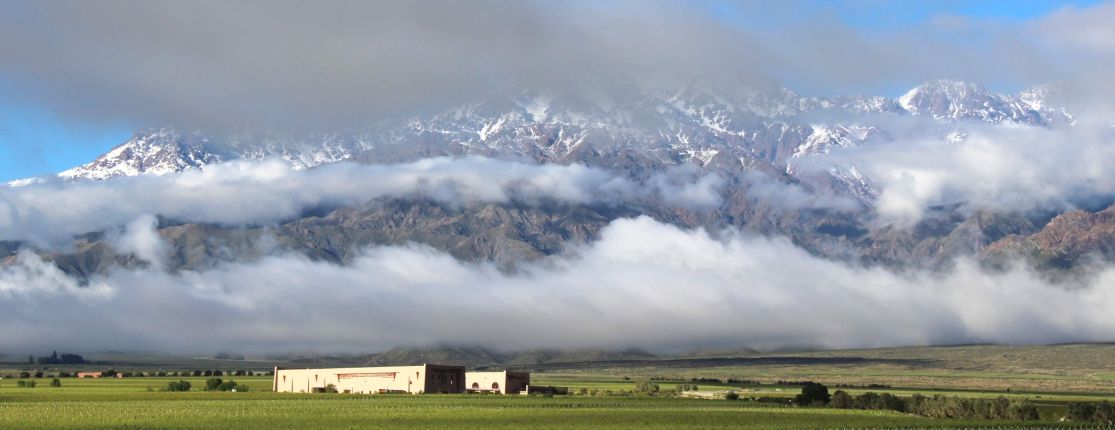Argentina

Chile has dominated South American wine exports but Argentina makes almost five times as much wine, and has been catching up fast on export markets, especially in the US.
Only in the 1990s, however, was business confidence in Argentina sufficient to justify the investment needed to drag its wineries into the twentieth century, and exports on a serious scale are a fraction of what they could be. The distinguishing feature of Argentine wine was for a long time the extraordinarily high yields from overhead trellises called parral with reliably sun-ripened grapes literally pumped full of melted Andean snow via irrigation channels constructed in the nineteenth century. Since the late 1980s vines have begun to be planted in cooler areas deliberately to prolong the ripening process, and trained carefully on wires for maximum quality of the resulting fruit. No wine producing country in the world made more progress in the closing years of the twentieth century (viticulturally and oenologically, if not necessarily financially).
The main Argentine wine region, Mendoza, is tucked up against the Andes and a long way from the capital Buenos Aires but less than an hour’s spectacular flight over the Andes from Santiago, the capital of Chile and its wine industry. Mendoza is a vast and extremely varied region, with the key to seriously high quality this close to the equator being altitude. In fact several of the best producers such as Catena and Terrazas de los Andes (a subsidiary of Moët & Chandon) specify precise vineyard altitudes on their labels. The higher the vineyard, the cooler the nights, which has a beneficial effect on acidity and colour, and the greater the effect of radiation on achieving precise wine flavours. Because of this there has been a land grab on suitable slopes of the Andean foothills, with parts of Tupungato and La Consulta in the Valle de Uco in particular a patchwork of embryonic vineyards planted by investors from all over the world at altitudes of up to 1,600 m (4,800 ft). Everyone seems to be trying to plant higher than his neighbour, with the result that some very fine Chardonnay and Pinot Noir (Salentein’s in particular) have already been produced, but presumably Nature will eventually impose some limit at which vines are reliably free of frost damage.
Malbec was for years Argentina’s most planted red wine grape and was therefore regarded by Argentines as distinctly infra dig (especially in relation to Cabernet Sauvignon), but to many outsiders it seems the perfect grape for Argentina’s relatively warm climate, producing rich, intensely fruity yet ageworthy wines which can be far more impressive than any Malbec-based Cahors from south-west France. After a period during which Malbec was ruthlessly pulled out to make way for more fashionable varieties, Argentine wine exporters now realize that Malbec represents their unique point of difference (much envied by their competitors across the Andes) and due effort is put into making velvety, welcoming wines from the particular strain of Malbec that has evolved here. After the Malbec was ripped out, the red grape known as Bonarda in Argentina – not the same as any of Italy's Bonardas – has became the most planted (and therefore least regarded by Argentines), with the vines being coaxed to produce lower yields of more flavourful, inexpensive, juicy wine for early drinking. Cabernet Sauvignon clearly has no problem ripening here, but Argentina’s strength is the wide range of grape varieties already planted in her extensive vineyards, thanks to successive waves of immigration from Italy, Spain and France. Tempranillo, Syrah, Pinot Gris/Grigio and (Tocai) Friulano are all capable of making fine wine in the right hands in Argentina. Sangiovese, Zinfandel, Barbera and Nebbiolo wait in the wings.
Mendoza can make fine wine at high altitudes and good value wine in the better managed vineyards lower down. Throughout much of Mendoza, summer hail is the major threat and sophisticated netting against this ruinous but regular phenomenon is as common a feature of vineyards here as irrigation channels and a view of the Andes in the distance. Dr Nicolas Catena’s stable of brands and names, now called Catena Zapata, is an obvious star in Mendoza but other reliable producers include Achaval-Ferrer, O Fournier, Viña Cobos (made by California Paul Hobbs), Poesia, Mendel and Trapiche at the top of its range.
The second most important wine region in terms of quantity is San Juan immediately north of Mendoza, but it is even hotter and is generally better suited to Argentina’s rather coarse vine specialities Criolla and Cereza. These pink-skinned grapes are used for grape concentrate and the deep-coloured, often slightly sweet white that is sold at rock bottom prices, often in cardboard cartons, within Argentina. Some producers are actively developing San Juan’s cooler sites, however, which shows a particular aptitude for Syrah. Well south of Mendoza in the romantically named Patagonia on the Rio Negro is another extremely promising area for viticulture. The climate is much cooler here, the wines tend to be more elegant, and firms such as Humberto Canale with its French-trained winemaker (far from uncommon in Argentina) and Noemia show just what can be achieved.
The only other area of obvious interest to export markets is the high-altitude vineyards around Cafayate in the province of Salta in the far north of the country. The local vine speciality here is a form of Torrontes which can yield flavourful, grapily aromatic dry whites – absolutely the last thing most wine drinkers would expect from Argentina. The highest vineyards in the world are in Salta, well to the north of here. Donald Hess's Colomé estate has some vines at altitudes of over 3,000 m (9,800 ft) above sea level.
See Wines of Argentina for more information on this region.